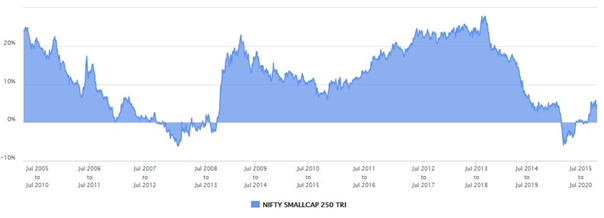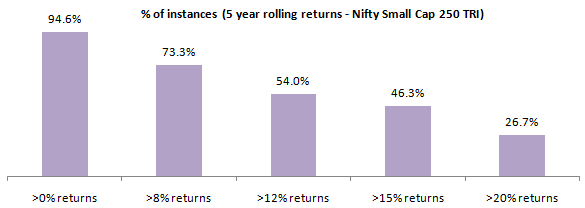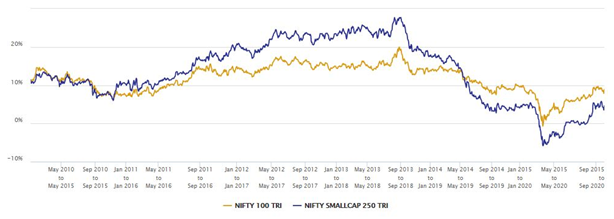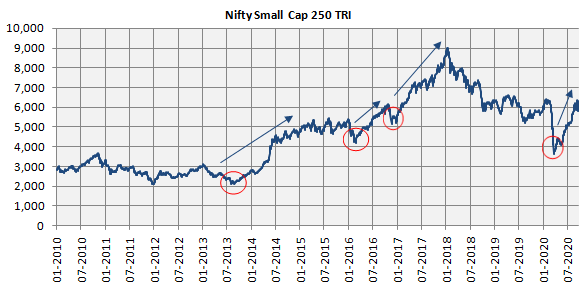Want to invest in SmallCap Mutual Funds: Consider Nifty Small Cap 250 Index

According to SEBI, stocks whose market Capitalizations are smaller than the 250th company by market Cap are classified as SmallCap stocks. SmallCap companies tend to be newer companies or emerging companies which have not yet reached the scale of operations associated with Mid Cap companies. These companies can be in sectors where large companies are not present. Due to their Small size, their revenue and earnings growth potential can be high compared to LargeCap companies which have reached a stable growth phase. While SmallCap stocks have the potential to outperform LargeCap and Mid Cap stocks in the long term, they are prone to significantly higher risks compared to LargeCap and Mid Cap stocks. SmallCap stocks usually have a very Large percentage of promoter ownership and relatively low institutional ownership.
What is Nifty SmallCap 250 TRI?
Nifty SmallCap 250 Index is the Index of the 251st to 500th companies by market Capitalization in the National Stock Exchange. The Nifty SmallCap 250 Index represents about 6.7% of the free float market Capitalization of the stocks listed on NSE as on September 15, 2020.The total traded value for the last six months ending March 2019, of all the companies comprising the Nifty SmallCap 250 Indexis approximately 11% of the traded value of all stocks on NSE (Source: NSE Indices Ltd.).
Total return Index or TRI is an Index which reflects both the price appreciation and dividends. Dividends are assumed to be re-invested at ex-dividend price in Total Returns Index or TRI. TRI is a better representation of an Index’s performance compared to a simple price Index like Nifty, Nifty 500 etc because it includes both Capital gains and dividends.
Performance of Nifty SmallCap 250 TRI
While SmallCaps have the potential to outperform LargeCap stocks, they also tend to be more volatile. Therefore, investors should always have long investment tenures for SmallCap stocks. In our view, investors should have minimum 5 year investment horizon for SmallCaps. The Nifty Smallcap 250 Index chart below shows the 5 year rolling returns of Nifty SmallCap 250 TRI over the last 10 years.
You can see that the Nifty Small Cap 250 Index returns are more than 10% annualized over 5 year investments in most of the instances. The median 5 year rolling return of the Nifty 250 Small Cap Index was 13.05% during this period, while the maximum 5 year return was 27.73%. The minimum 5 year return was -5.83%.

Source: Advisorkhoj Research. Disclaimer: Past performance may or may not be sustained in the future.
The chart below shows the percentage of instances 5 year rolling returns of Nifty SmallCap 250 TRI were over certain return levels. It has delivered 8%+ annualized returns over 5 year tenures in 73.3% of instances in the past. It delivered negative returns in only about 5% of the instances, while it delivered more than 15% returns in 46% of the instances over the 5 year investment tenures. So over sufficiently long investment tenures the risk / return trade-off in the scheme is good.

Source: Advisorkhoj Research. Disclaimer: Past performance may or may not be sustained in the future.
Volatility reduces over longer investment tenures
We have discussed a number of times in our blog that even though equity as an asset class is volatile, the risk of making a loss reduces over longer investment tenures. This holds true for SmallCaps, even though SmallCaps are the riskiest / most volatile among all the market Cap segments.
The table below shows rolling returns statistics of Nifty SmallCap 250 TRI over different investment tenures since the inception of the Index. We had at least 4 major bear markets for SmallCaps since the inception of Nifty SmallCap 250 TRI. However, the probability of making a loss reduces over long investment tenures – please note the last two columns, Standard Deviation and % instances of negative returns. Also note that the median returns do not change much over tenures longer than 5 years. Therefore, longer your investment tenure better is your risk / return trade-off in SmallCaps.

Source: Advisorkhoj Research. Disclaimer: Past performance may or may not be sustained in the future.
Small Caps outperform LargeCaps over long tenures
SmallCaps have the potential to outperform LargeCaps over long investment tenures. The Nifty Small Cap 250 Index chart below shows the 5 year rolling returns of Nifty SmallCap 250 TRI versus Nifty 100 TRI over the last 5 years. You can see that over 5 year tenures SmallCaps have generally outperformed LargeCap. SmallCaps have underperformed over the last couple of years due a variety of factors viz. (a) economic slowdown in India affected SmallCaps more than LargeCaps, (b) SmallCap valuations had run up in 2016 and 2017 and (c) COVID-19 pandemic and the stringent lockdown. However, the performance of these stocks is expected to improve once the economy recovers from the crisis it is facing now.

Source: Advisorkhoj Research. Disclaimer: Past performance may or may not be sustained in the future.
You can see in the table below that despite higher volatility, Nifty SmallCap 250 TRI has the potential of outperforming Nifty over sufficiently long investment tenures

Source: Advisorkhoj Research (1.1.2010 to 28.9.2020). Disclaimer: Past performance may or may not be sustained in the future..
Is this a good time to invest in SmallCaps?
SmallCaps have corrected sharply since 2018. From its peak in 2018, the maximum drawdown (fall from peak to trough) of Nifty SmallCap 250 TRI was 59%. In the past, deep corrections have provided attractive investment opportunities in SmallCaps (please see the chart below).Even though the SmallCaps have recovered a lot of ground from the March lows, you can see that they are still trading substantially lower than the previous high. Extrapolating historical trend, SmallCaps seem attractive at these levels.

Valuations are attractive
Nifty SmallCap 250 is trading at cheaper Price to Book values (2.17X) compared to Nifty 100 (3.25X). In terms of Price to Earnings multiple, Nifty SmallCap 250 has come down substantially from its highs and is now at a marginal discount to Nifty 50 and Nifty 100.
Dividend Yield of Nifty SmallCap 250 (1.66) is also more attractive than Nifty 100 (1.37) and the broader market, Nifty 500 (1.38). Also SEBI’s circular on multi-Cap funds may benefit SmallCap stocks as we may see increased mutual fund activity in the SmallCap segment.

Source: Nippon India MF, as 15.09.2020.
Why consider investing in Nifty Small Cap 250 Index?
- Exposure to SmallCap segment. The Nifty 250 Index stocks are spread over 35 industry sectors, in some of which LargeCaps do not have any presence
- There is no non-systematic (fund manager’s stock picking) risk as the fund will invest in the entire basket of Nifty SmallCap 250 Index
- Currently Nifty Small Cap 250 is trading at cheaper Price to Book values (2.17X) compared to Nifty 100 (3.25X)
- Dividend Yield of Nifty Small Cap 250 (1.66) is also more attractive than Nifty 100 (1.37)
- You do not need to have demat account to invest in Index Funds
- You can invest through SIP as well
- Since Index Funds are passive funds, the costs will be low
Conclusion
We believe that SmallCaps are attractive at these levels and there is considerable upside potential over long investment tenures given the secular long term growth story of India. Investors should be prepared for volatility and should have moderately high to high risk appetite for SmallCaps.
Nifty Small Cap 250 Index provides a good low cost opportunity for retail investors to invest in SmallCap Index Funds in India. You can buy Nifty Small Cap Index Fund either in lump sum or through SIP depending on your financial situation and investment needs. Investors should consult with their financial advisors if Nifty Small Cap 250 Index is suitable for their investment needs.
Mutual Fund Investments are subject to market risk, read all scheme related documents carefully.
RECOMMENDED READS
The information being provided under this section 'Investor Education' is for the sole purpose of creating awareness about Mutual Funds and for their understanding, in general. The views being expressed only constitute opinions and therefore cannot be considered as guidelines, recommendations or as a professional guide for the readers. Before making any investments, the readers are advised to seek independent professional advice, verify the contents in order to arrive at an informed investment decision.
Mutual Fund investments are subject to market risks, read all scheme related documents carefully.
Quick Links
Follow Nippon India MF
More About Nippon India MF
POST A QUERY






